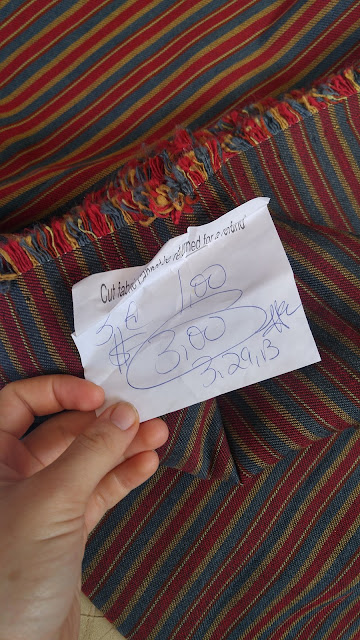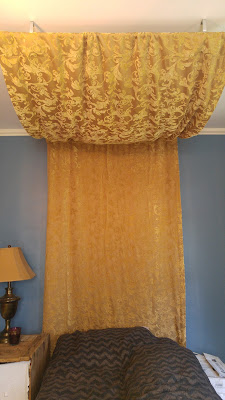I admit, going into this project I was pretty intimidated. I knew I wanted pockets, but I also knew that once I started there was no going back. And as I really liked the dress, failure was not an option. However, this came together so much more smoothly than I anticipated. I did get thinking halfway through that I should probably have gone off of someone else's tutorial for my first attempt. I did, basically, make this up as I went. Nonetheless, I am quite satisfied with the final product and I see myself doing it just the same in the future.
I realized an amazing aspect of adding your own pockets. They can be as big as you want them to be! Now, how many of you have pockets that won't even fit your hand? I know I do. And most skirts and dresses don't even have pockets! Anyway... I'm sure you've picked up on the fact that I'm pretty excited about this.
So, the pockets in this tutorial I guess are what you would call Welt pockets. Maybe not, I don't know my pocket styles very well. I'm hoping to eventually do a side seam pocket, I feel that could be added to a wider variety of garments, as (hopefully) they wouldn't be seen unless your hands were in them.
well... here goes, and god luck following my instructions. If you have any questions leave a comment, shoot me an email, send a carrier pigeon; I'll make sure to get back to you. Also, I do appologize for the quality of the pictures - I feel I say that an awful lot. That's what I get for working on these things too far into the night.
Also, keep in mind that your garment doesn't have to have two pockets. If getting two to match perfectly makes you faint-hearted just do one.
Step One: I started by making the piece of fabric that will go over the pocket. The only bit you'll see from the outside. I happened to have some of the same material as the dress and used that, but if you don't have the exact same fabric, fret not. A complementing fabric would be fine. If you went with something contrasting I think that would look amazing. Perhaps a colorful print on a solid or, if the skirt is a busy print, you could go with something solid and bright. Don't be afraid to make the pockets pop!
My pockets are 5 inches long. I cut the material 6 inches and folded the ends over a half inch. As you can see in the picture below, the top of the strip is a clean hem and the bottom is a raw edge. The bottom will be sewn under, so it's okay if it's not pretty. Height-wise they are about an inch and a half, with a half inch or so of seam allowance on the bottom. The measurements for the height don't have to be too exact, as long as the two pieces match, the length definitely does have to be exact.
 |
| Step 1 |
Step Two: Lay out your skirt and, being very precise with your measurements, determine where you want your pockets to be. If you are just doing one pocket this step isn't quite as vital. But if you'll be making two pockets you want to be sure they line up. How I did it was to measure across the waist to find the middle, measured down from the middle, determined how far apart the pockets should be, and pinned the inner pins accordingly. I then decided how steep and angle I wanted them to be at, pinned on side, measured down the side seams, then pinned the other side to match. You only need to pin each end of where the pocket slit will be.You can draw a line on the material to mark where the slit will be, rather than using pins, if you would prefer. Just make sure that however you are marking it that the slit will end up being an inch shorter than the piece you made in step one. That piece will need a half inch on either side to be attached later on.
note: Your pockets don't have to be at an angle as I did mine. They can be straight across.
 |
| Step 2 |
Step Three: Cut your slit. simply use sharp sewing scissors to cut along the previously determined line. I did not have an actual line, I just cut straight from one pin to the other. You can do the same, or, if it makes you more comfortable, you can draw a line to go by.
 |
| Step 3 |
Step Four: Cut the pocket lining. You will need four individual, matching pieces. If your chosen fabric has a right side and a wrong side, be sure that two of them face the opposite direction than the other two. I used a contrasting yellow to go with my red skirt, but you can use whichever color you'd like so long as it's a light weight, stretchless material. If your pockets are going to be horizontally across your pocket linings will either be squares or rectangles depending on how deep you want your pockets. Mine are square on the bottom and at the top they match the angle of the slit. Another option would be to make your pockets rounded at the bottom. Make them however you'd like. Heck, give it star shaped pockets for all I care. Just be sure that the top is an inch or so wider than the slit. I was bad and didn't measure anything while making my linings. You can eyeball it as I did, I'm sure.
 |
| Step 4 |
Step Five: With right sides together pin the lining pieces to the top and bottom of the slit. Be certain that the angle is correct. if you lower the upper piece, do they line up and go in the direction you want them to? If not, adjust them accordingly. Also see that they go right up to the edge of the slit.
 |
| Step 5 |
Step Six: Turn your dress/skirt inside-out and sew all the way around each slit, securing the lining in place. Sew fairly close to the edge. I would recommend a small zigzag stitch if either of the materials you are working with fray easily.
 |
| Step 6 |
 |
| Also Step 6 |
Step Seven: Pull the pocket lining pieces through the slit while the dress is still inside-out. pull them downward, into the position they will be when all is done. Line them up nicely. Pin them together if you so desire.
 |
| Step 7 |
Step Eight: Sew the lining pieces together on the sides and bottom to create your pocket. You can skip this step if you would like to, but the final product will not hold your phone very well, and we all know that's why we really want pockets.
 |
| Step 8 |
 |
| Also Step 8 |
Step Nine: Now, pull the pockets upward and pin them in place. This is simply to keep them out of the way for step 10. Now turn the dress/skirt right-side-out.
 |
| Step 9 |
Step Ten: With the pretty side down, place the little piece from step one just beneath the slit with that raw edge against the bottom of the slit. Sew it into place. Do just the same on each side.
 |
| Step 10 |
Step Eleven: Once more, put the garment inside-out. Unpin the pockets and repin them in the downward position. Again, this is just to keep them out of the way so they don't accidentally get sewn where they don't belong. Turn it to be inside-in
 |
| Step 11 |
Step Twelve: Fold the strips upward, to cover the slits. Iron Them flat if it seems necessary. Pin in place.
 |
| Step 12 |
Step Thirteen: Fasten the piece down by sewing little rectangles on each end of it. I suppose it doesn't have to be in rectangles, it could just be lines, or zigzag lines if you like. I personally like little rectangles. As you stitch this down it may (probably will) sew the very edge of the lining just a tad. That's okay.
 |
| Step 13 |
Voila. You now have pockets. That wasn't to hard now was it? I'd love if you would share your project with me so I can see how this worked out for you.
Thanks for the visit to my blog! Leave a comment, let me know what you think.


















































